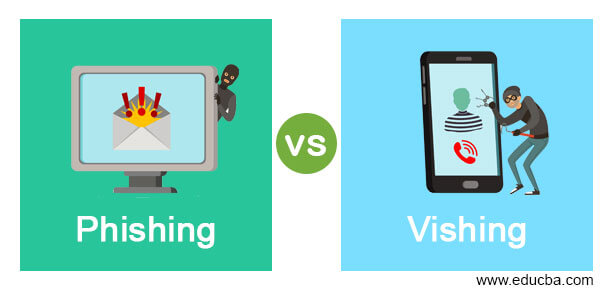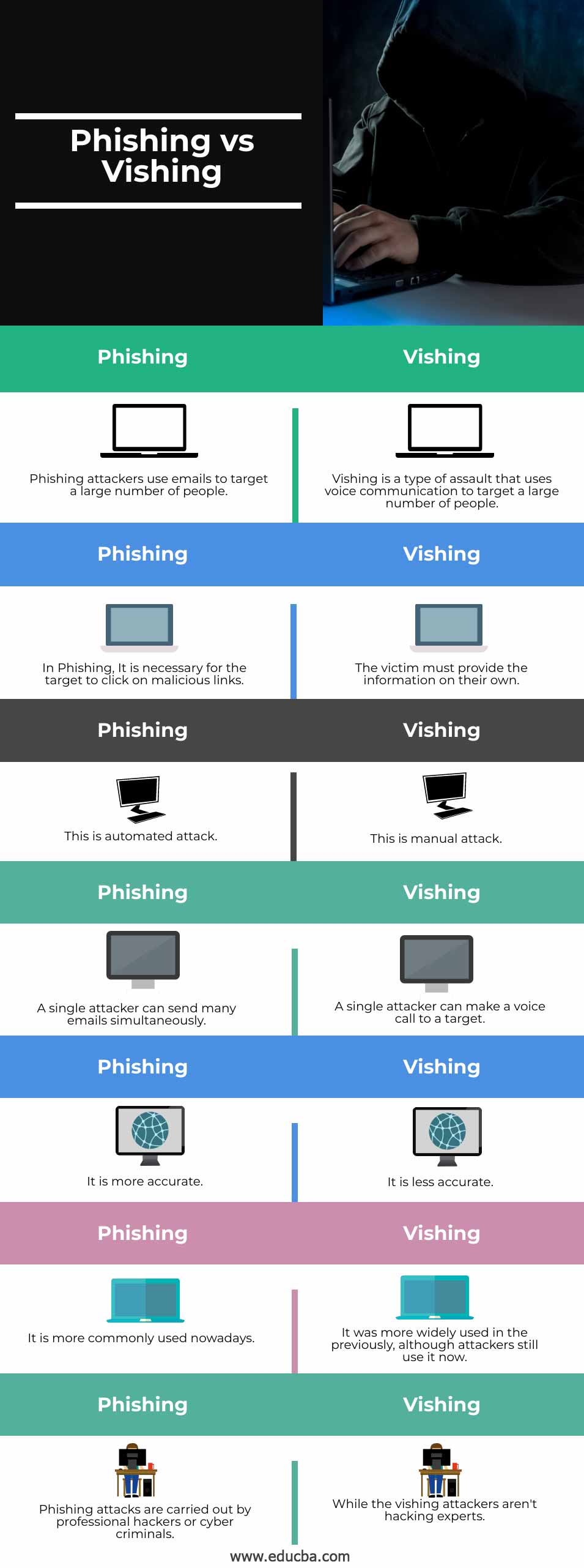Updated June 12, 2023

Difference Between Phishing vs Vishing
Attackers use a variety of email techniques to obtain private information from users. Login passwords, payment card numbers, and other sensitive information are examples of confidential information. Phishing and Vishing are examples of such attacks.
What is Phishing?
Phishing is a method cyber criminals use to get personal details like login information and bank details by sending an email that appears to be from a trusted source but is meant to deceive you into clicking on a malicious link or downloading a potentially dangerous attachment. This type of social engineering tries to get you to reveal personal data.
A cybercriminal could use Spoofing to make a phishing attempt look more legitimate. An attacker can impersonate an email domain or phone number to make it more legitimate. The more realistic the method of communication, the more likely the victim may fall victim to these tricks.
There are various types of Phishing –
- Phone Phishing
- Email Phishing
- Smishing and Vishing
- Clone Phishing
- Spear Phishing
What is Vishing?
The word “vishing” is made up of two different words: “voice” and “phishing.” Vishing is a phone-based scam performed by cybercriminals. Scammers employ social engineering to persuade people to disclose personal details. Vishing is a multi-step process cybercriminals use to get people to fall into their traps and expose their details to them.
The callers usually introduce themselves as people offering bank loans or rewards. They may say that the victim’s bank account has been blocked and that they require personal details such as bank and payment card information to resolve the problem. Hackers often use fraudulent websites to carry out the procedure and get people to provide the required credentials. Some popular vishing strategies involve faking an original phone number and making phone calls so that the targets cannot tell if the caller is legitimate or a scammer; if this method fails, the fraudsters frequently leave voicemails hoping the victim will return the call.
In computers, Vishing occurs through various channels aimed at making video and conference conversations using programs like Skype, Zoom, and others. Hackers use this software to trick targets into disclosing personal and confidential details, which are used to their advantage somehow. The central part of vishing fraud is manipulation, which leads to these crimes and victims falling into the attackers’ trap.
Head-to-Head Comparison Between Phishing vs Vishing (Infographics)
Below are the top differences between Phishing vs Vishing:
Key Differences Between Phishing and Vishing
Although Phishing and Vishing relate to the same type of cybercrime, several variations exist. The following are the key differences between Vishing and Phishing.
- Phishing attackers use emails to target a large number of people. At the same time, Vishing is a type of assault that uses voice communication to target many people.
- In Phishing, the target must click on malicious links. On the other hand, in a vishing attack, The victim must provide the information independently.
- Phishing is an automated attack. At the same time, Vishing is a manual attack.
- In Phishing, A single attacker can send many emails simultaneously. On the contrary, Vishing is a single attacker can make a voice call to a target.
- Phishing is more accurate. It is less accurate.
- Attackers are more commonly using Phishing nowadays, while Vishing was more widely used previously, although it is still employed by attackers today.
- Professional hackers or cybercriminals carry out phishing attacks, whereas vishing attackers are not hacking experts.
Comparison Table of Phishing vs Vishing
Given below table shows the comparison of Phishing vs Vishing:
| Sr. No | Phishing | Vishing |
| 1 | Phishing attackers use emails to target a large number of people. | Vishing is an assault that uses voice communication to target many people. |
| 2 | In Phishing, the target must click on malicious links. | The victim must provide the information on their own. |
| 3 | This is an automated attack. | This is a manual attack. |
| 4 | A single attacker can send many emails simultaneously | A single attacker can make a voice call to a target. |
| 5 | It is more accurate. | It is less accurate. |
| 6 | It is more commonly used nowadays. | It was more widely used previously, although attackers still use it now. |
| 7 | Phishing attacks are carried out by professional hackers or cybercriminals | While the vishing attackers aren’t hacking experts. |
Conclusion
In this article, we have seen key differences between Vishing and Phishing. We hope you will find this article helpful. Apart from that, a few more things may be done to avoid similar situations. Ignoring such calls and reporting and blocking the caller immediately is one of the most efficient techniques to avoid this. Scammers, on the other hand, frequently steal identities by spoofing phone numbers, making it even more difficult to determine whether or not their identity is legitimate. If you receive such a call, you might consider calling your bank’s executives to see if they are the ones who made the call in the first place. Also, hanging up is critical if the receiver has made no previous move. Phishing and vishing attacks can have devastating consequences. As a result, preventative measures should be taken to avoid vishing and phishing scams.
Recommended Articles
This is a guide to Phishing vs Vishing. Here we discuss the Phishing vs Vishing key differences with infographics and a comparison table. You may also have a look at the following articles to learn more –

